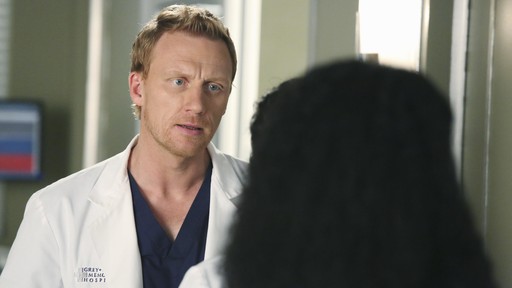
Encephalocele
Have you caught your breath yet? Because we operated on a patient who survived falling on THREE pieces of rebar. And we almost had a serious fire in the OR. Meanwhile, Paul finally woke up from his coma, Chest Peckwell almost died, a hugely pregnant Meredith fell down the stairs, and Matthew put on an insanely excellent flash mob proposal, to which April said yes. Oh, and I'm sorry, I almost forgot: A superstorm has begun to hit Seattle with hurricane-force winds.
Forget about catching your breath.
… So while we can't stand waiting for next week's finale, let's discuss cute Baby Tyler Sims.
Along with a facial cleft, Baby Tyler was born with an encephalocele.
While a facial cleft is an actual malformation or opening in the face, an encephalocele is a type of neural tube defect, which is a birth defect of the brain, spine, or spinal cord. The neural tube is the channel that closes during the first trimester of pregnancy to eventually form the brain and spinal cord. An encephalocele, which occurs when the neural tube does not completely close, can be described as a sac-like protrusion of the brain and its membranes through an opening in the skull. This opening may be located in the back of the skull, the midline of the upper part of the skull, or the area between the forehead and nose (such as in Tyler's case).
According to the Centers for Disease Control and Prevention, encephaloceles are considered rare – approximately 375 babies are born with this type of defect each year in the United States.
Currently, surgery is the only treatment for an encephalocele.
Neural tube defects do not have cures, but a variety of procedures can be helpful in preventing further injury as well as decreasing complications. As we saw in Episodes 922 and 923, the surgeons' primary goals consist of removing any non-viable tissue from outside of the brain, closing any skin defects, and reconstructing the area to prevent long-term deformity. The specific technique used obviously depends on the surgeon and characteristics of the defect, but larger protrusions, such as Tyler's, can typically be removed without causing more complications and only leave a scar. Additionally, when the sac contains only cerebrospinal fluid rather than actual brain tissue, the risk for complications is also greatly decreased.
If Tyler had not received surgery, what types of complications could he have experienced?
The severity of the complications actually depends on the location of the defect. And fortunately, Tyler's encephalocele was not located at the back of his skull because those particular defects can be associated with several neurological problems, including:
• Hydrocephalus, or buildup of fluid in the brain.
• Developmental delays.
• A smaller-sized head.
• Loss of strength in the limbs.
• Vision problems.
• Seizures.
• Difficulty with muscle movement.
Can encephaloceles be prevented at all?
Similar to other neural tube defects, the exact cause of encephaloceles is still unknown, therefore we still do not have concrete methods of prevention. However, researchers have advocated steps that can be taken for the pregnant mother to reduce her risk, such as adding folic acid to their diet as well as abstaining from smoking and alcohol during pregnancy.
Scientists also believe that a genetic component may be involved with the development of encephaloceles, but more research still needs to be completed.
For more information on encephaloceles, please visit the following:
http://www.cdc.gov/ncbddd/birthdefects/encephalocele.html



